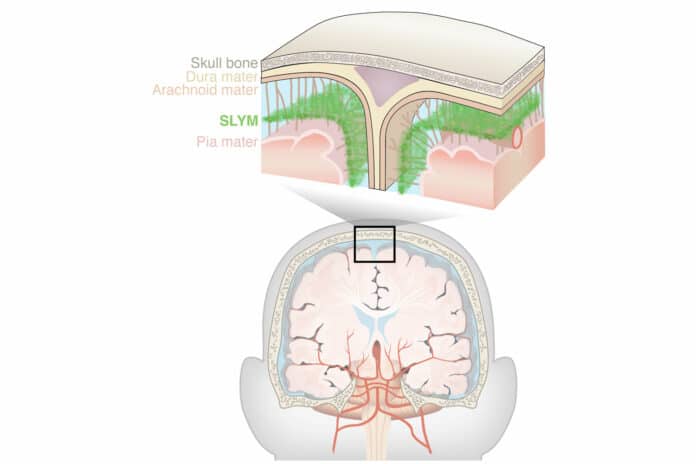The central nervous system is lined by meninges, classically known as dura, arachnoid, and pia mater. A new study by the University of Rochester Medical Center shows the existence of a fourth meningeal layer that compartmentalizes the subarachnoid space in the mouse and human brain, which the researchers name the SLYM, an abbreviation of Subarachnoidal LYmphatic-like Membrane.
This previously unknown component of brain anatomy acts as a protective barrier and platform from which immune cells monitor the brain for infection and inflammation. The study has transformed our understanding of the fundamental mechanics of the human brain and made significant findings to the field of neuroscience, including detailing the many critical functions of previously overlooked cells in the brain called glia and the brain’s unique process of waste removal, which the lab named the glymphatic system.
Nedergaard said, “The discovery of a new anatomic structure that segregates and helps control the flow of cerebrospinal fluid (CSF) in and around the brain now provides us a much greater appreciation of the sophisticated role that CSF plays not only in transporting and removing waste from the brain but also in supporting its immune defenses.”
The SLYM is a mesothelium-type membrane, also known to line the lungs and heart, among other human organs. Immune cells are often housed in and around mesothelium, which also protects organs. Møllgård, the study’s first author, raised the possibility that a comparable membrane might exist in the central nervous system. His work focuses on the systems of barriers that protect the brain and developmental neurobiology.
The new membrane is very thin and delicate and consists of only one or a few cells in thickness. Yet the SLYM is a tight barrier and allows only tiny molecules to transit; it seems to separate “clean” and “dirty” CSF.
This final finding suggests the potential function of SLYM in the glymphatic system, which requires a controlled flow and exchange of CSF to allow the entrance of new CSF while flushing the harmful proteins linked to Alzheimer’s and other neurological illnesses from the central nervous system.
Scientists noted, “This discovery will help researchers more precisely understand the mechanics of the glymphatic system, which was the subject of a recent $13 million grant from the National Institutes of Health’s BRAIN Initiative to the Center for Translational Neuromedicine at the University of Rochester.”
Maiken Nedergaard, co-director of the Center for Translational Neuromedicine at the University of Rochester, said, “Discovery of the SLYM opens the door for further study of its role in brain disease. For example, the researchers note that larger and more diverse concentrations of immune cells congregate on the membrane during inflammation and aging. When the membrane was ruptured during traumatic brain injury, the resulting disruption in the flow of CSF impaired the glymphatic system and allowed non-central nervous system immune cells to enter the brain.”
“These and similar observations suggest that diseases as diverse as multiple sclerosis, central nervous system infections, and Alzheimer’s might be triggered or worsened by abnormalities in SLYM function. The observations also suggest that the delivery of drugs and gene therapeutics to the brain may be impacted by SLYM function, which will need to be considered as new generations of biologic therapies are being developed.”
Journal Reference:
- Kjeld Møllgård, Felix R. M. Beinlich, Peter Kusk, Leo M. Miyakoshi, Christine Delle, Virginia Plá, Natalie L. Hauglund, Tina Esmail, Martin K. Rasmussen, Ryszard S. Gomolka, Yuki Mori, Maiken Nedergaard. A mesothelium divides the subarachnoid space into functional compartments. Science, 2023; 379 (6627): 84 DOI: 10.1126/science.adc8810
